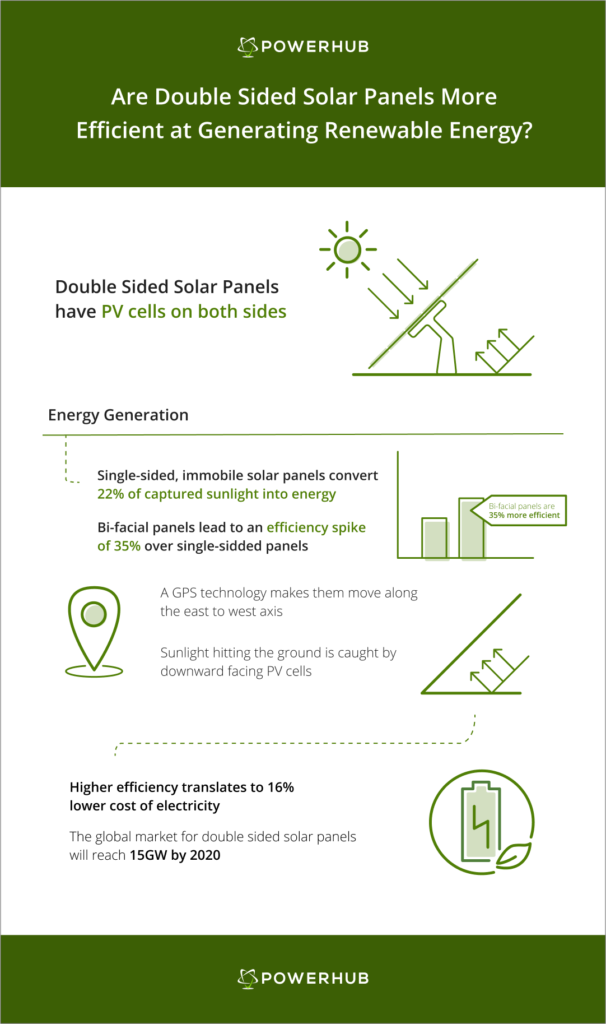Among the various sources of renewable power, solar has been on a roll for quite some time. At the end of 2019, the International Renewable Energy Agency estimated that the world saw a new high of 580.1GW of total installed solar PV. Meaning? Its popularity can no longer be hidden behind tons of CO2 emissions fossil fuels are responsible for.
Clearly, the cost of solar power has been on a downward trajectory for the last decade. Between 2009 and 2019, solar became 82% cheaper, bringing the levelized cost to $0.068/kWh.
So, what’s the next question in solar asset management? Efficiency. And that’s all sorted out, thanks to double-sided solar panels.
What Are Double-Sided Solar Panels?
As you know, a traditional solar set-up is mono faced, with gleaming glass tops on the front. Mounted atop fixed racks facing the sun. And within these cells, all the photovoltaic magic takes place.
Now, imagine the same shiny surface on the other side. Say hello to double-sided solar panels. These solar arrays are an improved version of your tried and trusted installations. However, this isn’t to say that bi-facial is a new technology.
Just like concentrated solar power, it’s been around for some time. However, it came with a hefty price tag. Well, until recently. With solar becoming the cheapest renewable energy source, an investment in double-sided arrays may just be worthwhile.
Are Double-Sided Solar Panels More Efficient at Generating Renewable Power?
Traditional solar panels convert 22% of captured sunlight into energy. This percentage is a result of best-in-class technologies. Even so, the question; ‘how to make solar panels more efficient’, has never really been laid to rest.
Undoubtedly, for good reason. Extensive research conducted by renewable energy experts at the Solar Energy Research Institute of Singapore (SERIS) shows that combining double-sided panels with dual-axis mounting racks can lead to an efficiency spike of 35%. While both these technologies are at work independently in various solar systems, combining them will be a simple, yet significant development.
So, as the sun’s radiation changes course and intensity throughout the day, mobile double-sided solar panels can adapt to ensure maximum exposure. A GPS technology embedded in the panel setup enables them to move along the east to west axis.
However, trackers, and their repair, are a costly O&M component. One that most solar experts think twice about. So, the next question you should ask is whether the efficiency spike outweighs this cost. Is your solar asset management team willing to put in the extra resources to manage and maintain dual axis mounts?
Nonetheless, even if bi-facial panels don’t have dual-axis trackers, they do boost efficiency. There’s always a portion of sunlight that hits the ground, and reflects from it. Downward facing panels are able to absorb these rays, converting them into additional clean power.
Therefore, as manufacturers fine-tune the minute details of double-sided panels, researchers predict an exponential growth in the solar PV market. And as a result, a further 16% reduction in the cost of electricity produced with solar.
Attention – IT leads, and asset managers. You can all vouch for the remarkable benefits this innovation will have on the financial solar asset management bottom line.
What’s more? The global capacity for double-sided panels will reach 15GW by the end of 2020. Now compare that to a large-scale nuclear reactor that has about 1GW of power capacity. Impressed?
Are We Ready to Switch to Double-Sided Solar Panels?

Double-sided panels are a great next step in renewable power. However, will they completely replace traditional setups? We’d say it’s easier said than done.
In this regard, an important question that arises is the disposing off of old panels. Where do they go? How will they be treated? Will double-sided arrays bring twice as much lead in the environment as single-sided panels?
In solar asset management, panel recycling or decommissioning has always been an ongoing debate. So, while the prospect of high efficiency and low costs is the solution to the world’s power worries, does it pose a threat to the environment?
Consequently, the concern of sustainability is an important one. And the only way forward, to a cleaner and greener planet, will be weighing this concern on the same scale as costs and efficiency.




